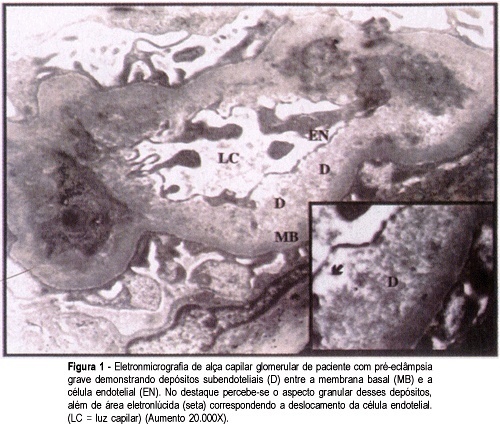Summary
Revista Brasileira de Ginecologia e Obstetrícia. 2004;26(8):619-624
DOI 10.1590/S0100-72032004000800005
PURPOSE: to analyze the relationship of the imune system with preeclamptic pregnancies, comparing lymphocyte and lymphocyte subset analyses of normal pregnant women to pregnancy-induced hypertensive women. To evaluate this immunological function, 40 pregnant women were studied at the "Irmandade da Santa Casa Hospital" of São Paulo: 20 women with normal pregnancies and 20 women with pregnancy-induced hypertension. From all these pregnant women peripheral blood samples were obtained and submitted to the following tests: lymphocyte and lymphocyte subsets analyses (CD4+, CD8+, CD4+/CD8 +CD3+, CD19+). Statistical analysis was performed by the Mann-Whitney test. RESULTS: the serum lymphocyte counts were decreased in women with preeclampsia (preeclamptic group 2295.10±1328.16; control group 3892.80±1430.85, p<0,05); and so were CD4+ (preeclamptic group 1188.80±625.61, control group; 1742.25±628.40, p<0.05); CD8+ (preeclamptic group: 774.00±371.31, control group 1175.70±517.72, p<0,05) and CD3+ (preeclamptic group 1958.65±983.78, control group 2916.95±1117.88, p<0,05). The other tests showed no significant differences between groups. CONCLUSION: the findings indicated a decreased number of lymphocytes, CD4+, CD8+ and CD3+ in preeclampsia.
Summary
Revista Brasileira de Ginecologia e Obstetrícia. 2004;26(3):185-192
DOI 10.1590/S0100-72032004000300003
PURPOSE: to investigate the glomerular alterations in patients with severe preeclampsia, as well as to evaluate the evolution of these lesions, relating them to the moment of the renal biopsy. METHODS: seventy-two pregnant women with hypertensive syndrome underwent renal biopsy in the puerperium. Appropriate samples for electron microscopic examination were obtained from 39 patients and grouped as follows: 25 with preeclampsia and 14 with superimposed preeclampsia. Biopsy findings were classified into: normal kidney, endothelial cell edema, mesangial expansion, mesangial interposition, subendothelial fibrinoid deposits, and podocyte fusion. RESULTS: the most frequent alterations found in both groups were subendothelial fibrinoid deposits and podocyte fusion. Endothelial edema was present in 84% of the preeclampsia patients and in 92.9% of the superimposed preeclampsia cases. There was no association between the degree of hypertension and the severity of endothelial edema. A tendency to mesangial interposition was observed in patients who had a biopsy after the seventh day after delivery. Podocyte fusion showed a significant association with 24-hour proteinuria. CONCLUSIONS: the above mentioned glomerular alterations represent a spectrum of complex and dynamic lesions that together represent the ultrastructural characteristics of preeclampsia which should no longer be diagnosed based only on the presence or absence of endothelial edema.

Summary
Revista Brasileira de Ginecologia e Obstetrícia. 2003;25(6):413-418
DOI 10.1590/S0100-72032003000600005
PURPOSE: to determine the existence of association between blood pressure rise and plasma ANP and BNP levels in pregnancies complicated by preeclampsia, considering the existence of a hypertensive state before pregnancy and supportive drug influence on these hormones. METHODS: in a case-control transversal study, 86 pregnant women were assessed regarding arterial pressure level and plasma ANP and BNP levels. Clinical and laboratory tests were carried out to diagnose preeclampsia and the use of hypotensive drugs and magnesium sulfate was considered. Hormone determinations were obtained through radioimmunoassay, after extraction in C18 Sep-pak columns. Correlation was investigated by means and regression analysis in the whole group of pregnant women and in specific groups, considering prior hypertension. RESULTS: plasma ANP values were 41.5±7.3, 78.4±13.1 and 89.2±13.4pg/mL (p<0.00001) and plasma BNP values were 79.5±15.8, 176.7±42.2 and 208.3±63.5 pg/mL (p=0.005), respectively, for mean blood pressure =107 mmHg, 107-139 mmHg and =140 mmHg. It was verified that the positive correlation between plasma ANP concentrations and pressure levels in preeclampsia did not depend on the existence of a hypertensive state before pregnancy (p<0.0001: preeclampsia and p<0.01: preeclampsia superimposed on chronic hypertension), whereas BNP dosages were not associated with the arterial pressure in the group with arterial hypertension prior to pregnancy (p=0.004: preeclampsia and p=0.18: preeclampsia superimposed on chronic hypertension). CONCLUSION: aggravation of hypertension in preeclampsia correlates with serum ANP and BNP concentrations, although BNP values may be influenced by the existence of a prior hypertensive state.
Summary
Revista Brasileira de Ginecologia e Obstetrícia. 2003;25(4):277-281
DOI 10.1590/S0100-72032003000400009
PURPOSE: the aim of the present study was to evaluate the accuracy of microalbuminuria to predict preeclampsia. METHODS: a prospective study of 45 consecutive diabetic gestations that were tested for microalbuminuria before the 18th week, between the 18th and 24th week and between the 32nd and 36th week of gestation. All patients had their prenatal care done from January 2000 to December 2001. The DCA 2000 microalbumin/creatinine assay is a quantitative method for measuring low concentrations of albumin, creatinine and the albumin/creatinine ratio in urine. According to laboratory standards, an albumin/creatinine ratio >16 mg/g (1.8 mg/mmol) indicates incipient renal damage and risk for preeclampsia. The sensitivity, specificity, positive and negative predictive values of the albumin/creatinine ratio were determined to predict the occurrence or the absence of preeclampsia, diagnosed through clinical criteria. RESULTS: of all patients, 17% developed preeclampsia. The sensitivity of albumin/creatinine ratio increased from 12.5% at 18 weeks to 25% between the 18th and 24th week and to 87% after the 32nd week. On the other hand, specificity presented a decreasing value from 97 to 89 and 83%, respectively). The positive predictive value was relatively low in the three different periods of evaluation (50, 33 and 53%, respectively. The negative predictive value was increased in the three stages of gestational age (83, 84 and 96%, respectively). CONCLUSIONS: quantification of microalbuminuria could correctly predict the absence of preeclampsia but was less accurate to predict the occurrence of the disease in diabetic pregnancies.